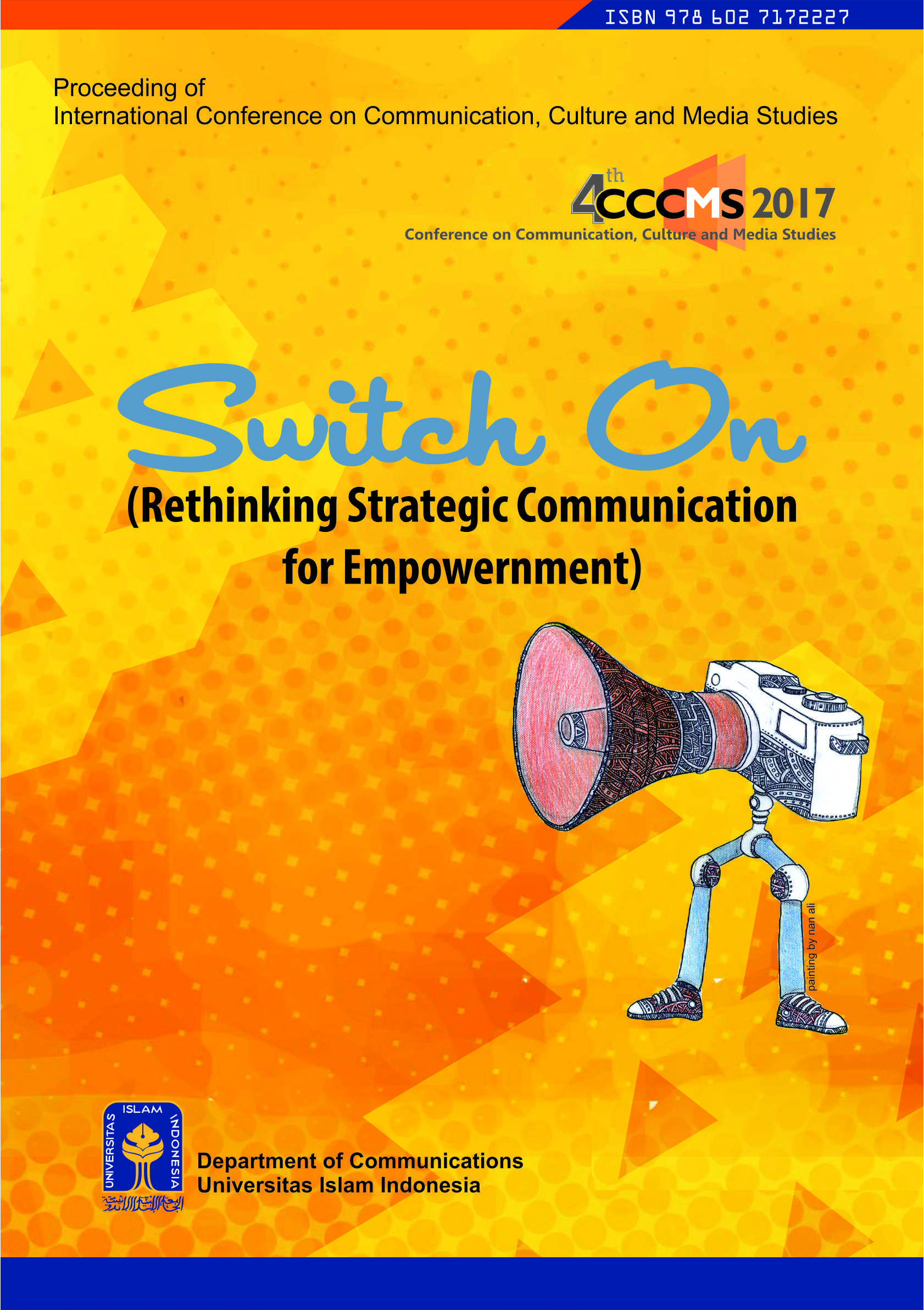Main Article Content
Abstract
We are all aware of how strong mass media is today in influencing our society’s mind and the way it construct our reality through their products. Film, as one of the products of mass media, attracts most people years after years due to the development of the story and the detail of cinematography to finally become a fortune for those who are making it. However, a film may also be able to tell a story while creating diverse interpretations at the same time. The Voices movie presents a story of a schizophrenic patient which brings the audience into the perspectives of the patient. This film will be analyze to unfold the messages behind it by using Critical Multimodality Analysis. The analysis will be utilized to analyze both, the movie clips and scripts, which results’ will be aim at revealing the hidden agenda behind this movie, through the eyes of the film producer, which is to give the understanding of Schizophrenic people’s conditions in their daily life based on their common symptoms. Furthermore, it will also be utilized to demonstrate the Critical Multimodality Analysis' use in Public Relations', especially in demonstrating how producers use texts and images as the resources to produce meaning, as well as for audience to make meaning.
Keywords: The Voices movie; Critical multimodal analysis; Schizophrenia; film;
Article Details
References
- Caple, H. (2013). Photojournalism: a social semiotic approach. Basingstoke: Palgrave Macmillan.
- Dijk, T. A. (1995). The Mass Media Today: Discourses of Domination or Diversity? Javnost - The Public,2(2), 28. doi:10.1080/13183222.1995.11008592
- Driscoll, P. (2014). “The Hitchcock Touchâ€: Visual Techniques in the Work of Alfred Hitchcock. International ResearchScape Journal,1.
- Janks, H. (1997). Critical Discourse Analysis as a Research Tool. Discourse: Studies in the cultural politics of eduation, 329-342.
- Kress, G., & Leeuwen, T. V. (2006). Reading images. Oxon: Routledge.
- Kress, G., & Leeuwen, T. V. (2010). Reading images: the grammar of visual design. London: Routledge.
- Machin, D., & Mayr, A. (2012). How To Do Chritical Discourse Analysis. California: SAGE Publications.
- Rasit, R. M. (2015). Structural Equation Modelling (SEM) Analysis of the Influence of Religious Films on Prosocial Behaviour of Audience. Asian Social Science, 11(18). doi:10.5539/ass.v11n18p42
- Scholes, R. E. (1982). Semiotics and interpretation. New Haven, CT: Yale University Press.
- Shank, G. (2002). Qualitative Research. A Personal Skills Aproach. New Jersey: Merril Prentice Hall.
- Walsh, M.P. (2005). Reading visual and multimodal texts : how is 'reading' different?. In Diane Hansford (Ed.), Multiliteracies & English Teaching K-12 in the Age of Information & Communication Technologies 2004 (pp. 1-14). Armidale, Australia: Australian Literacy Educators' Association.
- Wahl, O. F., & Kaye, A. L. (1992). Mental illness topics in popular periodicals. Community Mental Health Journal,28(1), 21-28. doi:10.1007/bf00756699
References
Caple, H. (2013). Photojournalism: a social semiotic approach. Basingstoke: Palgrave Macmillan.
Dijk, T. A. (1995). The Mass Media Today: Discourses of Domination or Diversity? Javnost - The Public,2(2), 28. doi:10.1080/13183222.1995.11008592
Driscoll, P. (2014). “The Hitchcock Touchâ€: Visual Techniques in the Work of Alfred Hitchcock. International ResearchScape Journal,1.
Janks, H. (1997). Critical Discourse Analysis as a Research Tool. Discourse: Studies in the cultural politics of eduation, 329-342.
Kress, G., & Leeuwen, T. V. (2006). Reading images. Oxon: Routledge.
Kress, G., & Leeuwen, T. V. (2010). Reading images: the grammar of visual design. London: Routledge.
Machin, D., & Mayr, A. (2012). How To Do Chritical Discourse Analysis. California: SAGE Publications.
Rasit, R. M. (2015). Structural Equation Modelling (SEM) Analysis of the Influence of Religious Films on Prosocial Behaviour of Audience. Asian Social Science, 11(18). doi:10.5539/ass.v11n18p42
Scholes, R. E. (1982). Semiotics and interpretation. New Haven, CT: Yale University Press.
Shank, G. (2002). Qualitative Research. A Personal Skills Aproach. New Jersey: Merril Prentice Hall.
Walsh, M.P. (2005). Reading visual and multimodal texts : how is 'reading' different?. In Diane Hansford (Ed.), Multiliteracies & English Teaching K-12 in the Age of Information & Communication Technologies 2004 (pp. 1-14). Armidale, Australia: Australian Literacy Educators' Association.
Wahl, O. F., & Kaye, A. L. (1992). Mental illness topics in popular periodicals. Community Mental Health Journal,28(1), 21-28. doi:10.1007/bf00756699
